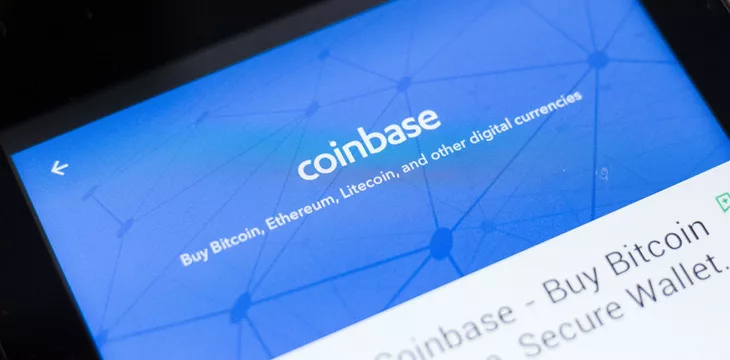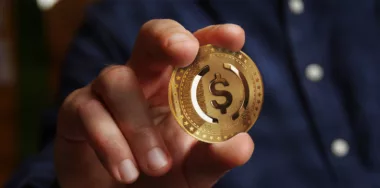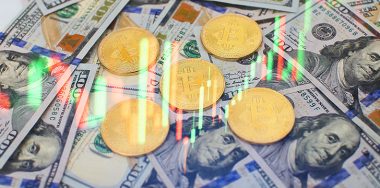Coinbase (NASDAQ: COIN) reported its sixth straight quarterly loss as trading volume on the digital asset exchange continues to evaporate and its stablecoin partnership struggles.
In figures released on August 3, Coinbase generated revenue of $707.9 million in the three months ending June 30, a 12.5% decline from the same period last year and 8.3% below the first quarter of 2023. Worse, the company’s net loss increased to $97 million from $79 million in Q1, marking Coinbase’s sixth consecutive quarterly loss.
The quarter also saw the digital asset exchange’s former mainstay revenue source—commissions on customer transactions—cede top place to ‘subscriptions and services’ revenue. The latter category contributed $335.4 million, down 7.3% from Q1, while transaction revenue was down nearly 13% to $327.1 million. The comparatively tiny ‘corporate interest and other income’ was the sole positive vertical, rising more than one-quarter to $45.4 million.
Both retail and institutional customers showed transaction fatigue in Q2, with retail fee revenue falling 12% to $310 million and institutional down 23.3% to $17.1 million. Overall trading volume was down a hefty 36.5% from Q1 to $92 billion, with retail off one-third to $14 billion and institutional tumbling 37% to $78 billion.
Coinbase had 7.3 million monthly transacting users (MTUs) in Q2, down from 8.4 million in Q1. And remember that Coinbase includes even ‘passive’ transactions in that figure, which includes customers who simply earned a reward payout by staking their assets on the platform. (By this time next year, Coinbase could feature a ‘monthly transacting tumbleweeds’ metric.)
As for what people were trading, BTC re-established some dominance, rising eight points from Q1 to 40%. ETH was essentially flat at 23%, meaning BTC’s rise came at the expense of shitcoins, which slipped seven points to 38% of total trading volume.
Looking ahead, Coinbase generated transaction revenue of $110 million in July, putting it on pace for another bleak quarter, although the company continues to “urge caution in extrapolating these results.” After all, who knows? A new Covid-19 variant could appear and with it another round of government stimulus checks like the kind that fuelled the last crypto bubble. Dare to dream…
Losing interest
As for subscriptions and services, the sole subcategory in positive territory was ‘blockchain rewards’ aka customer staking their tokens, such as ETH, in communal ‘validator’ pools. Rewards revenue was up nearly 19% to $87.6 million, a new record for this segment.
Sadly, the previous star performer—interest on the dollars held as reserves for USDC, the stablecoin controlled by Coinbase and Circle—tumbled 16.3% to $201.4 million. The slump came courtesy of the significant reduction in USDC’s market cap, which stood at $32.5 billion at the end of Q1 but closed out Q2 around $27.4 billion (and has since slid to $26.1 billion).
The slide is the hangover of USDC’s very rough Q1, which featured a brief depegging from its 1:1 ratio with the U.S. dollar following the collapse of Silicon Valley Bank. Circle kept $3.3 billion of its reserves in a single account at SVB and, were it not for the ensuing government bailout, USDC’s market cap might currently be measured in the millions, with an equally dire effect on Coinbase’s bottom line.
Coinbase’s interest income also took a hit from the fiat currency it holds on behalf of its customers. At the end of June, Coinbase counted $3.8 billion on hand, down from $5.4 billion at the end of March. Coinbase blamed this decline on “outflows from a small group of crypto-native institutions,” whose logos are likely glued to the dartboard in Coinbase CEO Brian Armstrong’s office.
Armstrong was asked about USDC on Thursday’s analyst call, and he responded by saying: “Binance actually moved some of their funds from USDC into another stablecoin.” It’s unclear whether this is a reference to rival exchange Binance’s September 2022 decision to forcibly convert their customers’ USDC into BUSD, a stablecoin in which Binance was a partner (but didn’t end well). Or perhaps Binance more recently sold off its remaining USDC to support FDUSD or its other new stablecoin projects.
Regardless, Armstrong went on to cite “data we have in the last six or seven weeks” to make the claim that USDC’s market cap “is up net of that.” Precisely what he’s talking about here is anyone’s guess, because USDC has been on a nearly uninterrupted downward trajectory for the past year, and that decline accelerated rapidly following the SVB debacle.
‘Everyone gets a trophy’ quarter
Coinbase enjoyed a drop in operating expenses during Q2, falling nearly 13% to $781.5 million. Coinbase spent far less on technology & development in Q2, while it also ridding itself of the ‘restructuring’ toll from its multiple rounds of layoffs. Coinbase finished Q2 with 3,406 staff on its payroll, nearly 1,600 fewer than this time last year.
That said, while Coinbase reported reduced transaction volume in Q2, the cost of those transactions rose 12.2%, while sales & marketing costs were up nearly one-third (blame its pricey NBA partnership, evidently). Coinbase admitted that the fact that it was forced to hike the rewards rate it paid customers for holding on to their USDC “also contributed” to these increased costs.
Coinbase doled out another $200 million in stock-based compensation in Q2 and expects this figure to rise in Q3 “as our expense recognition is not linear.” Nothing like continually rewarding failure to turn things around, we always say.
Lies, damned lies, and lawyers
Legal fees were also up in Q2, thanks to Coinbase’s ongoing fight with the U.S. Securities and Exchange Commission (SEC). The day after its Q2 results, Coinbase filed a motion seeking the outright dismissal of the SEC suit for all the half-baked reasons it has previously offered, including its view that none—NONE!—of the tokens it has ever offered meet Gary Gensler’s definition of an unregistered security.
Armstrong and Coinbase’s legal eagle Paul Grewal were quick to celebrate last month’s limited ruling that Ripple’s token XRP wasn’t a security, seeing their salvation in the judge siding with the SEC’s opponents. But reality struck with a later ruling in a different SEC civil suit that basically played iceberg to Coinbase’s titanic legal arguments. Regardless, Coinbase’s Friday filing cites the opinion expressed in the XRP ruling as “substantially identical to those alleged here.”
A week ago, Armstrong told the Financial Times that, prior to filing its suit against Coinbase, the SEC had informed the exchange that “you need to delist every asset other than Bitcoin.” Coinbase was forced to walk back this claim after the SEC publicly insisted that it had never made such a request.
This is par for the course for Armstrong, who loves to take an absolutist position when it suits his purposes. But when pressed on the undeniable similarities between unregistered securities and the assets on his exchange, he played his “I’m not a lawyer” card and changed the subject.
Regardless, since the SEC has made it plain that nearly all digital assets—including ETH—are unregistered securities, we’ll leave it up to this site’s founder to spell out the reality for Brian: “The Coinbase model is dead man walking in the US. It’s over for anything but the three Bs in the U.S.: Bitcoin BSV and its protocol forks BTC and BCH.”
Everything must go!
Investors were largely nonplussed by the Q2 results, as Coinbase shares closed Thursday essentially flat at $90.75, then dipped 1% in after-hours trading. Analysts were equally unmoved, with Goldman Sachs suggesting Coinbase’s actual value was closer to $51.
CEO Armstrong appears to share this belief, unloading nearly $15 million worth of his Coinbase shares in July (and dumped another $2.7 million on August 1). That was more than four times the sum he sold in June, and while Coinbase’s share price has risen since then, the number of shares Armstrong unloaded in July was a whopping 161,372, easily eclipsing the nearly 119,000 shares he dumped in March.
For even more perspective, Armstrong’s July sales accounted for nearly 30% of the total $51.4 million worth of shares he’s unloaded in the two years since the company’s direct listing on the Nasdaq exchange. It’s almost as if he knows something bad is about to happen (just like in the month following that Nasdaq debut).
BaseBALD
On the analyst call, Armstrong was eager to talk up Base, Coinbase’s new Ethereum ‘Layer 2’ solution that soft-launched in February but still isn’t ready for prime time. The rationale behind Base is that it will help alleviate the congestion that plagues Ethereum’s main layer and leads to outrageous transaction fees.
Armstrong said Thursday that Base will be monetized through “sequencer fees,” which sound an awful lot like Ethereum’s validators following the network’s switch to a proof-of-stake consensus mechanism (which FYI, made ETH even more like a security).
Armstrong said sequencer fees “can be earned when any transaction is executed on Base … Coinbase can run one of these sequencers as others can over time.” Base “is being decentralized over time” but meanwhile “a lot of developer interest has happened.”
He’s not wrong on that last point. Base is proving well-suited to mimicking Ethereum’s reputation as the network that launched a million utility-free shitcoins (aka unregistered securities—oh, the irony). Just last weekend, someone launched a new token on Base called BALD—playing on Armstrong’s shiny pate—which quickly doubled in value as speculators poured ETH into its smart contract. Predictably, its deployer rugged BALD holders the very next day, netting a nearly $6 million profit.
Based, as the kids like to say.
Lightning strikes (out)
A week ago, Armstrong retweeted a link to a Coinbase Wallet video featuring “the coffee shop of the future, where USDC payments are instant and gas-free.” Predictably, neither the name nor location of this USDC-friendly coffee shop was deemed important enough to mention, likely because it exists only in the minds of Coinbase management.
Armstrong’s tweet prompted an irritated reply from Jack Dorsey, whose Block payment processor has integrated the Lightning Network, another ‘Layer 2’ solution for the equally clogged BTC main layer. Dorsey wanted to know why Armstrong would “continue to ignore” BTC and Lightning.
After several days of awkward silence, Armstrong replied to Dorsey, offering meek assurances that Coinbase was “looking into how to best add Lightning.”
On Thursday’s analyst call, Armstrong was reminded that Lightning launched in 2015 and still hasn’t achieved anything approaching critical mass in public consciousness. Armstrong said Lightning was “frankly a little bit complex, just the way that liquidity pools have to be spun up, how transactions could be received and sent on a mobile device where the app is not always in the foreground.”
Armstrong thinks Ethereum’s Layer 2’s—including, ahem, Base—are further ahead than Lightning, both in simplicity and popularity. But hey, when it comes to Layer 2’s, “everybody has their own favorite solution, and that’s a good thing. I’m glad a lot of ideas are being tried. But we can help by enabling the best ones and rallying people around good solutions so that we get a little bit more consistency, interoperability across the industry as well.”
One can easily imagine Dorsey shooting Armstrong an angry DM after the call for this ongoing public display of disunity. After all, Block and Coinbase are founding members of the Crypto Open Patent Alliance (COPA), a group established for the sole purpose of suing Dr. Craig Wright so they can use his patent library without having to pay him for the privilege.
Wright supports the BSV blockchain, which boasts an infinitely scaling main layer and thus has no need for a Layer 2. Combine that with ultra-low transaction fees and you have what’s considered a ‘good solution’ to a problem unnecessarily created by developers looking to steer people onto proprietary off-ramps.
Solving real-world problems? Now that’s based.
Follow CoinGeek’s Crypto Crime Cartel series, which delves into the stream of groups—from BitMEX to Binance, Bitcoin.com, Blockstream, ShapeShift, Coinbase, Ripple,
Ethereum, FTX and Tether—who have co-opted the digital asset revolution and turned the industry into a minefield for naïve (and even experienced) players in the market.
New to blockchain? Check out CoinGeek’s Blockchain for Beginners section, the ultimate resource guide to learn more about blockchain technology.









